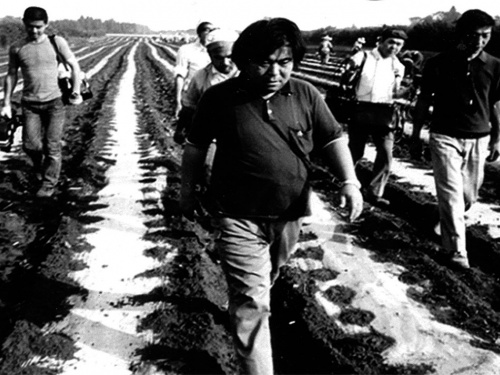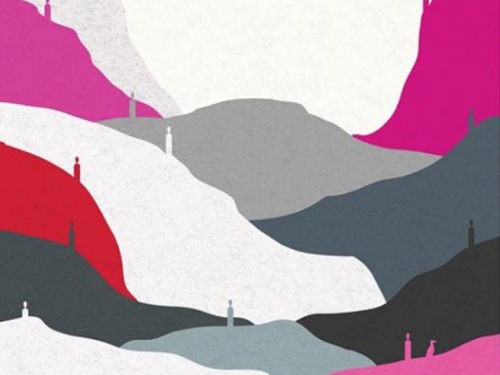Excitement in the Experiment: An Interview with Catherine Marcangeli
We spoke to Catherine Marcangeli, Paris-based art historian, author and curator of First Happenings: Adrian Henri in the ‘60s and ‘70s, about Adrian Henri and the current exhibition of his work at the ICA.
What were you aiming for in your curation of this exhibition?
Adrian Henri is best known as a "Liverpool poet", as a painter or as the leader of the band Liverpool Scene. This display focuses on a lesser-known aspect of his work: happenings. Adrian organised happenings in Liverpool as early as 1962. He saw happenings as a logical development from his collages: in his poetry as in his paintings, he often collaged images from everyday pop culture. He went on to create environments and then staged happenings that were like 3D collages of pictures, sounds and words.
What was the significance of this form of practice at the time?
It was very radical, unprecedented in Britain. Yet audiences didn't seem too resistant. One 1962 newspaper article recalls that people even seemed to enjoy having bottle tops, magazines and advertising material fall on their heads while city noises blared out of tape recorders.
This is probably due to the fact that the audience was mostly young, open-minded and had often attended the live poetry readings given in the city by Adrian, Roger McGough and Brian Patten. Their poetry, usually performed to music, had become part of popular culture. So, even though the happenings must have seemed like strange experiments, the audience didn't feel alienated. Being experimental and radical without being elitist was a key political concern for Adrian.
How did you translate this interdisciplinarity into the exhibition?
The show tries to highlight the ingredients that composed these happenings: poetry, music, assemblage and performance. So I've gathered artworks, newspaper reviews of poetry readings, rock posters, audio and video footage, photographs and other documentation that give an idea of all the concurrent activities. These events were not only multi-disciplinary but also very collaborative, in that they involved different artists (poets like McGough or Pete Brown, local music groups like The Roadrunners or The Clayton Squares and actors) as well as the audience.
Henri’s work is informed by a diverse range of influences, yet also rooted in Liverpool. Can you elaborate on the significance of Liverpool in his work?
His frame of reference was diverse and international, from Symbolism, Dada and Surrealism to the New York assemblage artists and Pop. Yet he felt that the artist and the writer needed to work with whatever was at hand, their immediate environment. Using specific references made the work feel more real. There would be no point in a British beat poet aping American rhythms and idioms. They had to find their own voice and their own subject matter. If you’re anchored, you have a "realness" about what you’re doing.
Also there was a freedom to not working in the capital, you could be more experimental. He had exhibitions in London, notably at the ICA, but wasn't part of the London art scene. John Willett had written Art in a City about the art scene in Liverpool, leading to a group exhibition of Liverpool artists at the ICA. In 1968, Mike Kustow, then ICA director, gave Adrian his first solo show: Adrian Henri Painter/Poet.
Adrian Henri’s work has often been described as autobiographical. How do you see the relationship between his life and work?
Just like the local references, the element of autobiography gives the work a greater feeling of reality. You start with something autobiographical and turn it into something that can have a universal value. In a love poem Who? he writes:
"who
wears my dressing gown
and always leaves the sleeves turned up."
That’s a very specific detail, but it has meaning for any reader. It becomes a cipher for intimacy, love, loss.
Adrian was a painter, an art school teacher, an unlikely rock n’ roll star, and all his activities fed into each other. He wrote in Notes on Painting and Poetry that he saw no reason, apart from time shortage, to stick to one activity. The collapsing of barriers between media was natural to him.
What do you hope visitors will take from the exhibition?
This sense of excitement in the experiment - the idea that you can try things out, be deadly serious about the work without being precious about it.
Tell us something we don’t know about Adrian Henri.
Every summer, as a teenager and a student, Adrian worked on a fairground - that's where he learned rhyming slang. He also picked up broken pieces of rides, shooting targets and carnival ephemera that made their way into Pop collages. There too, his instinct was to work with whatever was at hand. ■
First Happenings: Adrian Henri in the ‘60s and ‘70s runs 27 January – 15 March. There will be a panel discussion exploring Adrian Henri's work in poetry, music and art on February 28 2015.
Visit the Adrian Henri website to learn more about Adrian Henri and listen to audio recordings of his work.
This article is posted in: Exhibitions, Interviews
Tagged with: interview, Q&A, From the Archive, Adrian Henri, Catherine Marcangeli, poetry, Exhibitions, Pop, Liverpool, Happenings





